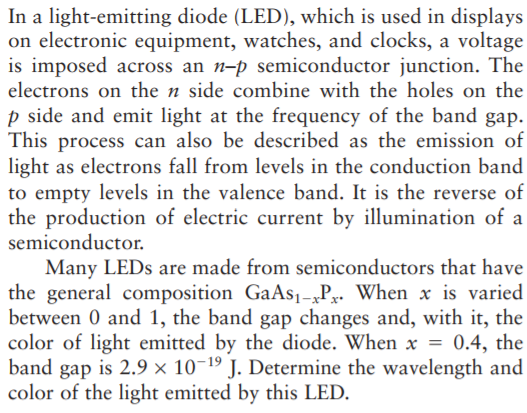In a light-emitting diode (LED), which is used in displays on electronic equipment, watches, and clocks, a voltage is imposed across an n-p semiconductor junction. The electrons on the n side combine with the holes on the p side and emit light at the frequency of the band gap. This process can also be described as the emission of light as electrons fall from levels in the conduction band to empty levels in the valence band. It is the reverse of the production of electric current by illumination of a semiconductor. Many LEDS are made from semiconductors that have the general composition GaAs1-„Pr. When x is varied between 0 and 1, the band gap changes and, with it, the color of light emitted by the diode. When x = 0.4, the band gap is 2.9 × 10-19 J. Determine the wavelength and color of the light emitted by this LED.
In a light-emitting diode (LED), which is used in displays on electronic equipment, watches, and clocks, a voltage is imposed across an n-p semiconductor junction. The electrons on the n side combine with the holes on the p side and emit light at the frequency of the band gap. This process can also be described as the emission of light as electrons fall from levels in the conduction band to empty levels in the valence band. It is the reverse of the production of electric current by illumination of a semiconductor. Many LEDS are made from semiconductors that have the general composition GaAs1-„Pr. When x is varied between 0 and 1, the band gap changes and, with it, the color of light emitted by the diode. When x = 0.4, the band gap is 2.9 × 10-19 J. Determine the wavelength and color of the light emitted by this LED.
Modern Physics
3rd Edition
ISBN:9781111794378
Author:Raymond A. Serway, Clement J. Moses, Curt A. Moyer
Publisher:Raymond A. Serway, Clement J. Moses, Curt A. Moyer
Chapter12: The Solid State
Section: Chapter Questions
Problem 1P
Related questions
Question

Transcribed Image Text:In a light-emitting diode (LED), which is used in displays
on electronic equipment, watches, and clocks, a voltage
is imposed across an n-p semiconductor junction. The
electrons on the n side combine with the holes on the
p side and emit light at the frequency of the band gap.
This process can also be described as the emission of
light as electrons fall from levels in the conduction band
to empty levels in the valence band. It is the reverse of
the production of electric current by illumination of a
semiconductor.
Many LEDS are made from semiconductors that have
the general composition GaAs1-„Pr. When x is varied
between 0 and 1, the band gap changes and, with it, the
color of light emitted by the diode. When x = 0.4, the
band gap is 2.9 × 10-19 J. Determine the wavelength and
color of the light emitted by this LED.
Expert Solution
This question has been solved!
Explore an expertly crafted, step-by-step solution for a thorough understanding of key concepts.
This is a popular solution!
Trending now
This is a popular solution!
Step by step
Solved in 2 steps with 2 images

Recommended textbooks for you

Modern Physics
Physics
ISBN:
9781111794378
Author:
Raymond A. Serway, Clement J. Moses, Curt A. Moyer
Publisher:
Cengage Learning

Glencoe Physics: Principles and Problems, Student…
Physics
ISBN:
9780078807213
Author:
Paul W. Zitzewitz
Publisher:
Glencoe/McGraw-Hill

Physics for Scientists and Engineers with Modern …
Physics
ISBN:
9781337553292
Author:
Raymond A. Serway, John W. Jewett
Publisher:
Cengage Learning

Modern Physics
Physics
ISBN:
9781111794378
Author:
Raymond A. Serway, Clement J. Moses, Curt A. Moyer
Publisher:
Cengage Learning

Glencoe Physics: Principles and Problems, Student…
Physics
ISBN:
9780078807213
Author:
Paul W. Zitzewitz
Publisher:
Glencoe/McGraw-Hill

Physics for Scientists and Engineers with Modern …
Physics
ISBN:
9781337553292
Author:
Raymond A. Serway, John W. Jewett
Publisher:
Cengage Learning